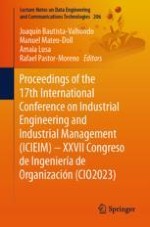This book presents selected papers from the 17th International Conference on Industrial Engineering and Industrial Management in 2023. The Conference was promoted by ADINGOR (Asociación para el Desarrollo de la Ingeniería de Organización) and organized by the Universitat Politècnica de Catalunya, Spain, on July 6th and 7th, 2023. The book provides a comprehensive overview of contemporary research and practical applications in various domains of industry and academia. Spanning a wide array of topics, readers will delve into studies on prosocial choice replication, project risk prioritization through Monte Carlo simulation, linear representation of greenhouse gas emissions, barriers to total productive maintenance implementation, and critical examinations of emerging technologies like ChatGPT and blockchain in educational and industrial contexts. Additionally, case studies explore themes such as influencer impact on student purchasing behavior, lean manufacturing, additive manufacturing parameter definition, and the application of Benford's Law in network science. The book also delves into sustainability concerns, including last-mile delivery solutions, carbon footprint reduction in public transport, and integration of operations strategies into circular supply chains. From advanced optimization models to the role of artificial intelligence in machinery design and workforce scheduling, this compilation serves as a valuable resource for scholars, practitioners, and students alike, offering insights into the forefront of research and innovation shaping contemporary industries and academic disciplines.
